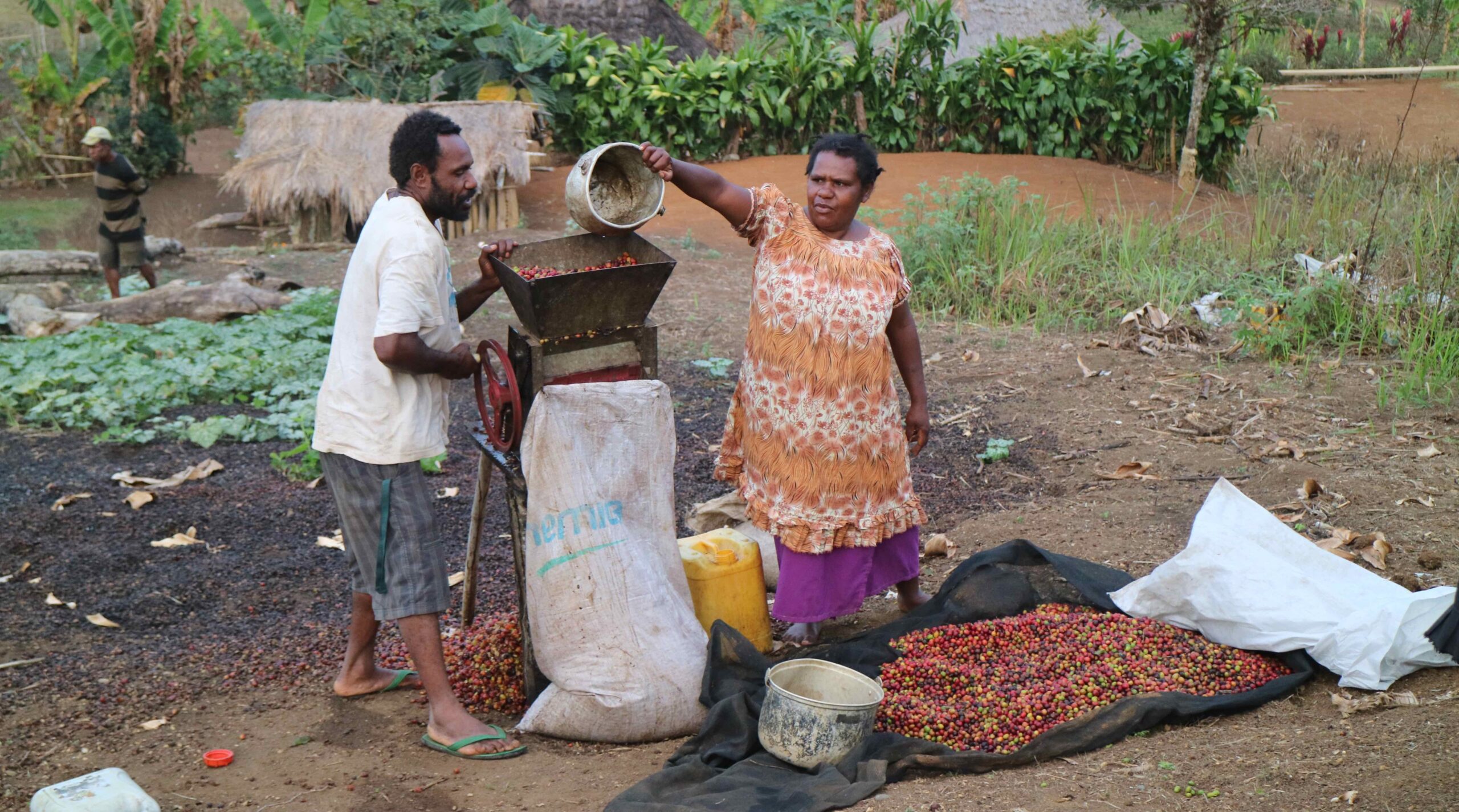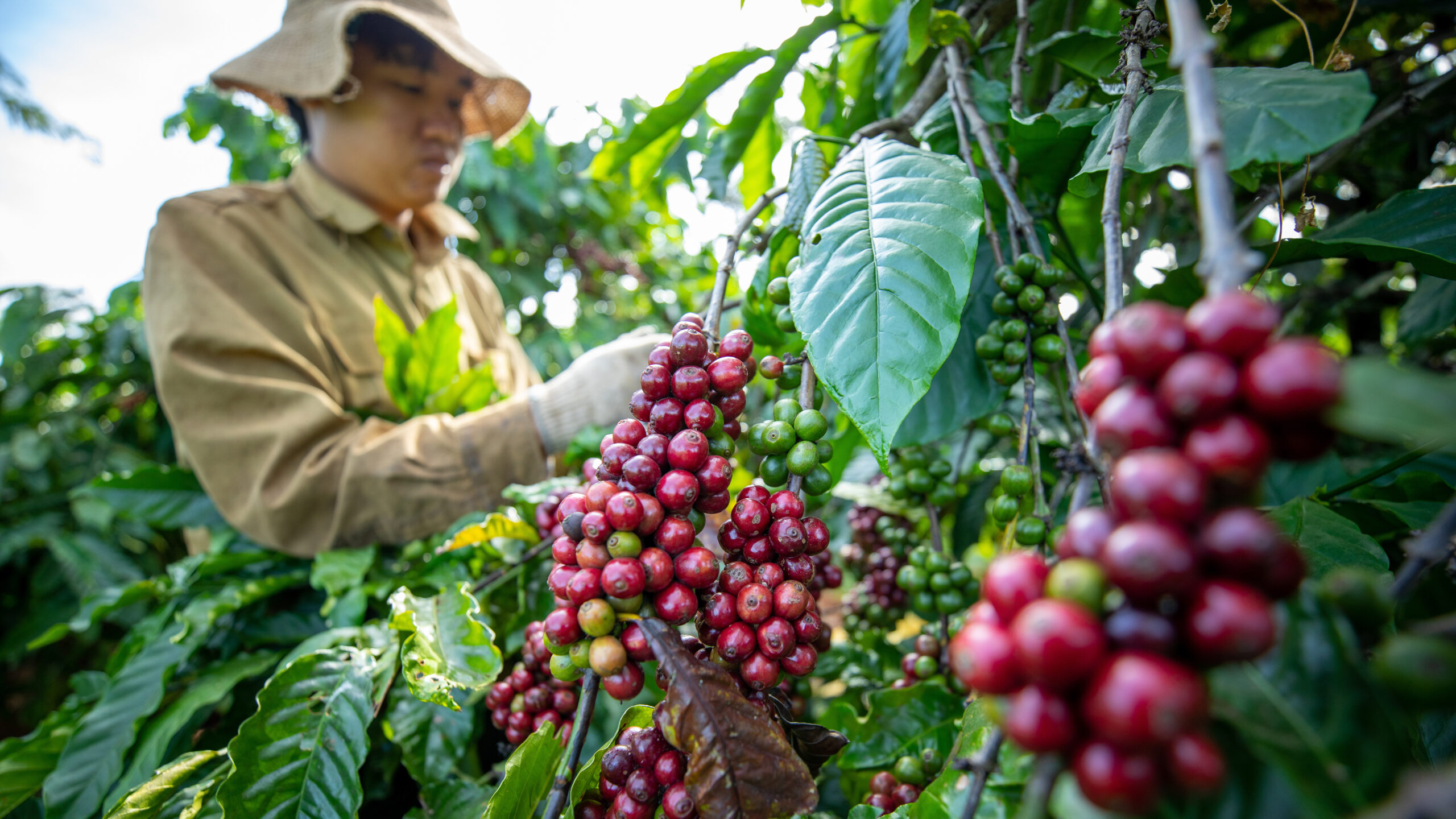Coffee is one of the most important smallholder cash crops in Papua New Guinea. It accounted for $156 million of export earnings, 13% of agricultural export revenues, and 1.4% of total export revenues in PNG in 2021. According to the PNG Rural Household Survey 2023, approximately 55% of sampled households in the highlands produce coffee.
During March and April 2024, IFPRI collaborated with the University of Goroka (UoG) to conduct gender-differentiated focus group discussions with coffee producers in Simbu and Eastern Highlands provinces to better understand the challenges and opportunities associated with coffee production and marketing in PNG. We completed 24 focus groups, each with 10 community members, discussing production, input usage, sales volume, production shocks, pest control, labor needs and market access.
Sampled communities varied with respect to coffee-production scale, pest management, and marketing channels. On average, households reported owning two to three coffee gardens, with most trees aged 15 years or older. To calculate an approximate range of coffee yield per hectare, we asked producers to estimate the coffee yields of different-aged trees by drawing a line on the coffee-bean bags used to transport output to processors in town. Additionally, we asked focus groups to estimate the share of trees, by age, that are grown on an average household’s coffee block. Furthermore, we measured seven coffee blocks in seven different villages to count the number of trees by age category per one hectare area.
According to respondents, within a coffee block, a quarter of trees were aged between four and 15 years and equivalent shares were reported for trees aged between 15 and 30 years and above 30 years, respectively (Figure 1). Based on the dimensions and tree count of the selected blocks, we estimate that 3,000-4,000 coffee trees are grown per hectare of land. There are three harvest cycles for coffee within the focus group areas. For example, for trees aged from four to 15 years, the first harvest is the largest and constitutes about 50% of the overall yield, while the second and third harvests make up 30% and 20% respectively.
Given this, we measured the second-harvest yield of an average coffee tree (non-dwarf) in the Kofena community by picking and weighing the ripe cherries from three trees of different ages. For trees aged between 15 and 30 years, the second harvest yielded 0.63 kilograms of ripe red cherries. For the older trees (aged 30+ years) and younger trees (age four to 15 years) the weighed yield was 0.18 kg and 0.12 kg, respectively. By considering the share estimates of first and third harvest for different-aged trees, along with the measured yield from the second harvest, we calculated the weight of red cherries harvested from each age category of coffee tree.
Using the conversion formula provided by World Bank 1986 and the PNG Coffee Industry Corporation (CIC) Handbook, approximately 1 kg of ripe red cherry yields 0.21 kg dry parchment (partially processed coffee beans). Based on the estimated red cherry yield, approximately 417 kg to 560 kg of dry parchment can be harvested per hectare in the focus group study area. Similar results were reported in the 2017 ACIAR report on coffee-based farming systems in the highlands of PNG, indicating that households in Bena and other Eastern Highlands Province districts produced an average of 522 kg and 386 kg of dry parchment per hectare per year respectively.
Compared to other countries such as Colombia and Indonesia (the second and eleventh largest producers of Arabica coffee, respectively), the estimated PNG parchment yield per hectare is substantially lower. For example, Colombia and Indonesia produce an average of 1,080 kg (USDA 2023) and 937 kg (USDA 2020) of dry parchment per hectare.
We identify low coffee yield as a significant challenge in the PNG highlands, which is further exacerbated by pest infestations, particularly from the coffee berry borer (CBB), a small species of beetle that lives, feeds, and breeds inside coffee berries. Over three quarters of the sample communities reported losing more than half of their harvest to berry borer infestations last season.
Lack of market access and price inconsistency pose another challenge for coffee producers. During the last harvest season (March-June 2023), dry coffee prices ranged between 3.5 and 7.0 PGK ($0.90-$1.81) per kg, with the highest price being paid at the onset and end of the season when coffee bean supply is relatively low. Most growers received a standard price per kilogram for their output irrespective of quality. However, communities associated with coffee associations or located near coffee processors benefited from extension services to improve output quality and negotiate quality premiums (an extra 2 or 3 PGK per kg) for their harvest. Furthermore, an overall low adoption of coffee certification in our sample suggests an important unrealized potential for achieving higher premium market values.
To overcome these production challenges, efforts should be directed towards improving yield and quality through improved farm practices and integrated pest management strategies. Having access to cost effective pest control solutions and guidance on the correct usage of fertilizers, soil management, and proper pruning practices are some crucial steps to boost production and control CBB attacks.
Establishing and providing financial support to coffee associations can strengthen market ties, enabling farmers to negotiate better prices. Encouraging direct contracts with international buyers could provide profitable market opportunities and financial incentives to ensure quality output, as seen in one village in our sample that directly supplied green beans to a U.S. coffee roaster and received an average 11-13 PGK per kg.
While the Coffee Industry Corporation (CIC) and exporters like PNG Coffee Roasters and Monpi Coffee offer extension certification and provide support to coffee associations in accessing domestic and global markets, an additional opportunity to increase market value for PNG coffee is to identify areas where organic coffee certification can be ascertained. However, price premiums on organic coffee production must be built into a transparent production, grading, and marketing system that incentivizes and rewards producers for high quality output.
Rishabh Mukerjee is a Research Analyst with IFPRI's Development Strategies and Governance Unit; Helmtrude Sikas-Iha is an IFPRI consultant and Program Coordinator based in Port Moresby, PNG; Damaris Warambukia is an Administrative Officer at the University of Goroka’s Center for Social and Creative Media Division (CSCM). This post first appeared on DevPolicyBlog. It is based on research that has not yet been peer-reviewed. Opinions are the authors'.
The authors acknowledge Harry Gimiseve and Wendy Safi for assisting the team with focus groups; their contributions were essential for our improved understanding of coffee-farming communities.
Funding for this work was provided by the Australian Department of Foreign Affairs and Trade and the Australian Centre for International Agricultural Research.







